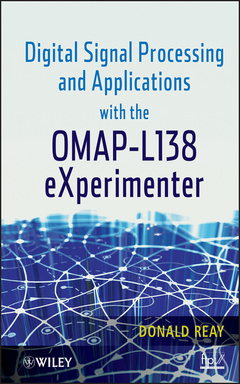Description
Digital Signal Processing and Applications with the OMAP - L138 eXperimenter
Author: Reay Donald S.
Language: English
Subject for Digital Signal Processing and Applications with the OMAP...:
Keywords
experimenter; latest; dsp; omapl; concepts; teaches; signal; system; handson; inexpensive; processing; contains; processor; applications; demonstration; algorithms; concentrates; book; realtime; implemented; core; program
Approximative price 158.68 €
In Print (Delivery period: 14 days).
Add to cart360 p. · 16.1x90024.2 cm · Hardback
Description
/li>Contents
/li>Biography
/li>
The OMAP-L138 eXperimenter is the latest inexpensive DSP development system to be adopted by the Texas Instruments University Program. The OMAP-L138 processor contains both ARM and DSP cores and is aimed at portable and mobile multimedia applications. This book concentrates on the demonstration of real-time DSP algorithms implemented on its C6748 DSP core.
Digital Signal Processing and Applications with the OMAP-L138 eXperimenter provides an extensive and comprehensive set of program examples to aid instructors in teaching DSP in a laboratory using audio frequency signals—making it an ideal text for DSP courses at senior undergraduate and postgraduate levels.
Subjects covered include polling-based, interrupt-based, and DMA-based I/O methods, and how real-time programs may be run using the board support library (BSL), the DSP/BIOS real-time operating system, or the DSP/BIOS Platform Support Package.
Chapters include:
Analog input and output with the OMAP-L138 eXperimenter
Finite impulse response filters
Infinite impulse response filters
Fast Fourier transform
Adaptive filters
DSP/BIOS and platform support package
Each chapter begins with a review of background theory and then presents a number of real-time program examples to reinforce understanding of that theory and to demonstrate the use of the OMAP-L138 eXperimenter and Texas Instruments Code Composer Studio integrated development environment.
List of Examples xiii
1. OMAP-L138 Development System1
1.1 Introduction 1
1.1.1 Digital Signal Processors 3
1.2 Hardware and Software Tools 4
1.2.1 Zoom OMAP-L138 eXperimenter Board 6
1.2.2 C6748 Processor 6
1.2.3 Code Composer Studio IDE 6
1.2.4 Installation of Code Composer Studio Software Version 4 and Support Files 7
1.3 Initial Test of the Experimenter Using a Program Supplied with this Book 8
1.4 Programming Examples to Test the Experimenter 14
1.5 Support Files 31
1.5.1 Initialization and Configuration File (L138_aic3106_init.c) 31
1.5.2 Header File (L138_aic3106_init.h) 32
1.5.3 Vector Files (vectors_intr.asm and vectors_poll.asm) 32
1.5.4 Linker Command File (linker_dsp.cmd) 34
Exercises 36
References 37
2. Analog Input and Output with the OMAP-L138 eXperimenter38
2.1 Introduction 38
2.1.1 Sampling, Reconstruction, and Aliasing 39
2.2 TLV320AIC3106 (AIC3106) On-Board Stereo Codec for Analog Input and Output 39
2.3 Programming Examples Using C Code 41
2.3.1 Real-Time Input and Output Using Polling, Interrupts, and Direct Memory Access 41
2.3.2 Real-Time Sine Wave Generation 64
References 102
3. Finite Impulse Response Filters103
3.1 Introduction to Digital Filters 103
3.1.1 FIR Filter 103
3.1.2 Introduction to the z-Transform 105
3.1.3 Properties of the z-Transform 107
3.1.4 z-Transfer Functions 109
3.1.5 Mapping from the s-Plane to the z-Plane 109
3.1.6 Difference Equations 111
3.1.7 Frequency Response and the z-Transform 112
3.1.8 Ideal Filter Response Classifications: LP, HP, BP, and BS 112
3.1.9 Window Method of Filter Design 113
3.1.10 Window Functions 114
3.1.11 Design of Band-Pass and High-Pass Filters Using Frequency Shifting 120
3.2 Programming Examples Using C And ASM Code 123
References 158
4. Infinite Impulse Response Filters159
4.1 Introduction 159
4.2 IIR Filter Structures 160
4.2.1 Direct Form I Structure 160
4.2.2 Direct Form II Structure 161
4.2.3 Direct Form II Transpose 162
4.2.4 Cascade Structure 164
4.2.5 Parallel Form Structure 165
4.3 Impulse Invariance 166
4.4 Bilinear Transformation 167
4.4.1 Bilinear Transform Design Procedure 169
4.5 Programming Examples Using C and ASM Code 169
4.5.1 Design of a Simple IIR Low-Pass Filter 169
Reference 211
5. Fast Fourier Transform212
5.1 Introduction 212
5.2 Development of the FFT Algorithm with Radix-2 213
5.3 Decimation-In-Frequency FFT Algorithm with Radix-2 214
5.4 Decimation-In-Time FFT Algorithm with RADIX-2 218
5.4.1 Reordered Sequences in the Radix-2 FFT and Bit-Reversed Addressing 220
5.5 Decimation-In-Frequency FFT Algorithm with Radix-4 221
5.6 Inverse Fast Fourier Transform 223
5.7 Programming Examples Using C Code 223
5.7.1 Frame- or Block-Based Processing 233
5.7.2 Fast Convolution 258
References 278
6. Adaptive Filters279
6.1 Introduction 279
6.2 Adaptive Filter Configurations 280
6.2.1 Adaptive Prediction 280
6.2.2 System Identification or Direct Modeling 281
6.2.3 Noise Cancellation 281
6.2.4 Equalization 283
6.3 Performance Function 283
6.3.1 Visualizing the Performance Function 285
6.4 Searching for the Minimum 285
6.5 Least Mean Squares Algorithm 287
6.5.1 LMS Variants 288
6.6 Programming Examples 288
7. DSP/BIOS and Platform Support Package307
7.1 Introduction to DSP/BIOS 307
7.1.1 DSP/BIOS Threads 307
7.1.2 DSP/BIOS Configuration Tool 308
7.1.3 DSP/BIOS Start-Up Sequence 309
7.1.4 Hardware Interrupts 310
7.1.5 Software Interrupts 320
7.1.6 Tasks and Idle Functions 322
7.1.7 Periodic Functions 327
7.1.8 Real-Time Analysis with DSP/BIOS 329
7.2 DSP/BIOS Platform Support Package 329
References 335
Index 337

